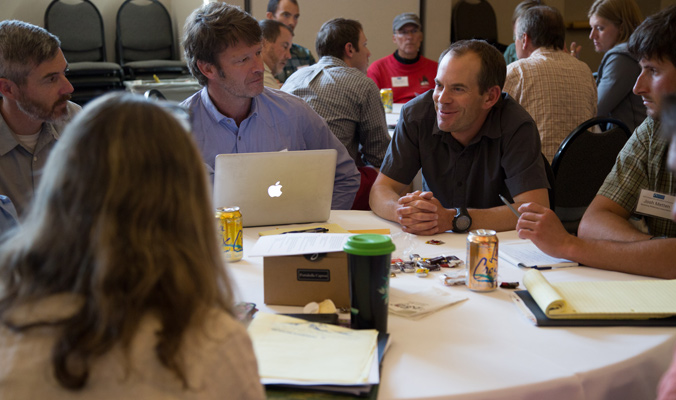There’s something about a landscape covered in snow. Close your eyes and think of one of your first memories of snow. What did it look like, feel like, smell like? Where were you, and how old? This is how Kerry McClay started his presentation last weekend at the Winter Wildlands Alliance Grassroots Conference.
Over the course of three days, winter enthusiasts gathered in Golden, Colorado. Leaders from the USDA Forest Service, Snowmobile Associations, The Wilderness Society, Defenders of Wildlife and more gathered to collaborate and share information regarding policy on our public lands when they are covered in snow.

Conference attendees during a breakout session during the Winter Wildlands Alliance Grassroots Conference. [Photo] Kt Miller
One of the biggest topics discussed during the conference was the new Over-Snow Vehicle (OSV) Rule that became law on February 26, 2015. Now before you click to the next YouTube sensation, hang tight, because this could effect you in a BIG way, and there is a LOT you can do to affect the outcome. Essentially, prior to this rule, there was only restriction on motorized vehicle use on Forest Service lands in the summer.
We are all familiar with this. There are roads, trails and gates, and each area is managed differently—some areas are open to motorized traffic, others are closed and some are gated until certain dates. Dirt bikes and four-wheelers can’t just go drive all over the forests and meadows; they have to stay on roads and trails. It makes sense in the summer, but in the winter, at least until recently, there wasn’t a national rule, and motorized vehicles could go pretty much wherever they wanted.
So here’s the deal with the new OSV Rule: all National Forests are now required to create a winter travel plan. That means designating areas for motorized users, non-motorized users and areas that are closed. Prior to the new OSV Rule, the paradigm was essentially “open unless designated closed [to motorized vehicles],” but the new rule switches that to “closed unless designated open,” according to Alison Flint from The Wilderness Society National Forest Action Center.
In the next few years each National Forest will be going through and designating these areas. New maps will be drawn, and new rules put in place. So here is where you come in. Your local Forest Service District Ranger needs to know the following:
- Where are important non-motorized areas (for backcountry skiing, snowshoeing, ice climbing)?
- Where are important motorized areas (for snowmobiling, snowbiking, mixed use)?
- Where is there fragile wildlife habitat that needs protection?
- Where are user conflict is occurring? What thoughtful suggestions on respectful and realistic solutions do you have to these conflicts?
The way to do this—which Hilary Eisen, WWA’s Recreation Planning Coordinator, detailed in her presentation—is by reaching out to your local district. Find out when they will be working on their Winter Travel Plan, and get involved early, before or during the scoping process.

Winter Wildlands’ Executive Director Mark Menlove (center) and keynote speaker Donny Roth. [Photo] Kt Miller
When asked what Leslie Weldon, Deputy Chief of the USDA Forest Service, would want backcountry skiers to know, she said, “I want to thank you for being part of the solutions.” It’s important that we work together to develop plans that allow everyone to seek the experiences they desire on our public lands in winter.
When Kerry McClay asked us to close our eyes on the first day of the conference, I thought back to when I was a kid, maybe five or six years old, walking down the street on which I grew up. I remembered huge snow piles on the side of the road and giggling in delight as my dad swung me by my arms, up into the air and over a fence into a deep snowdrift on the other side. I remember asking him to toss me again and again, over and over, I just loved disappearing, sinking, into the deep drifts.
So after a long weekend of big words, and head-scratching conversations, I decided to step back a bit and ask people one simple question: “What do you love about winter?” That’s why everyone showed up to sit in a conference room for three days instead of riding their mountain bike or taking their kayak down the river—we’ve all had a moment sometime during our lives when we connected with the wonder of winter, and that life-giving frozen water that falls from the sky.
“What do you love most about winter?”
[metaslider id=8404]
—
Kt Miller is a photographer and Winter Wildlands Alliance Ambassador based in Cooke City, Montana. She regularly contributes to Backcountry Magazine and shares more stories at ktmiller.photo and ktmillerphoto.blogspot.com.










Related posts: